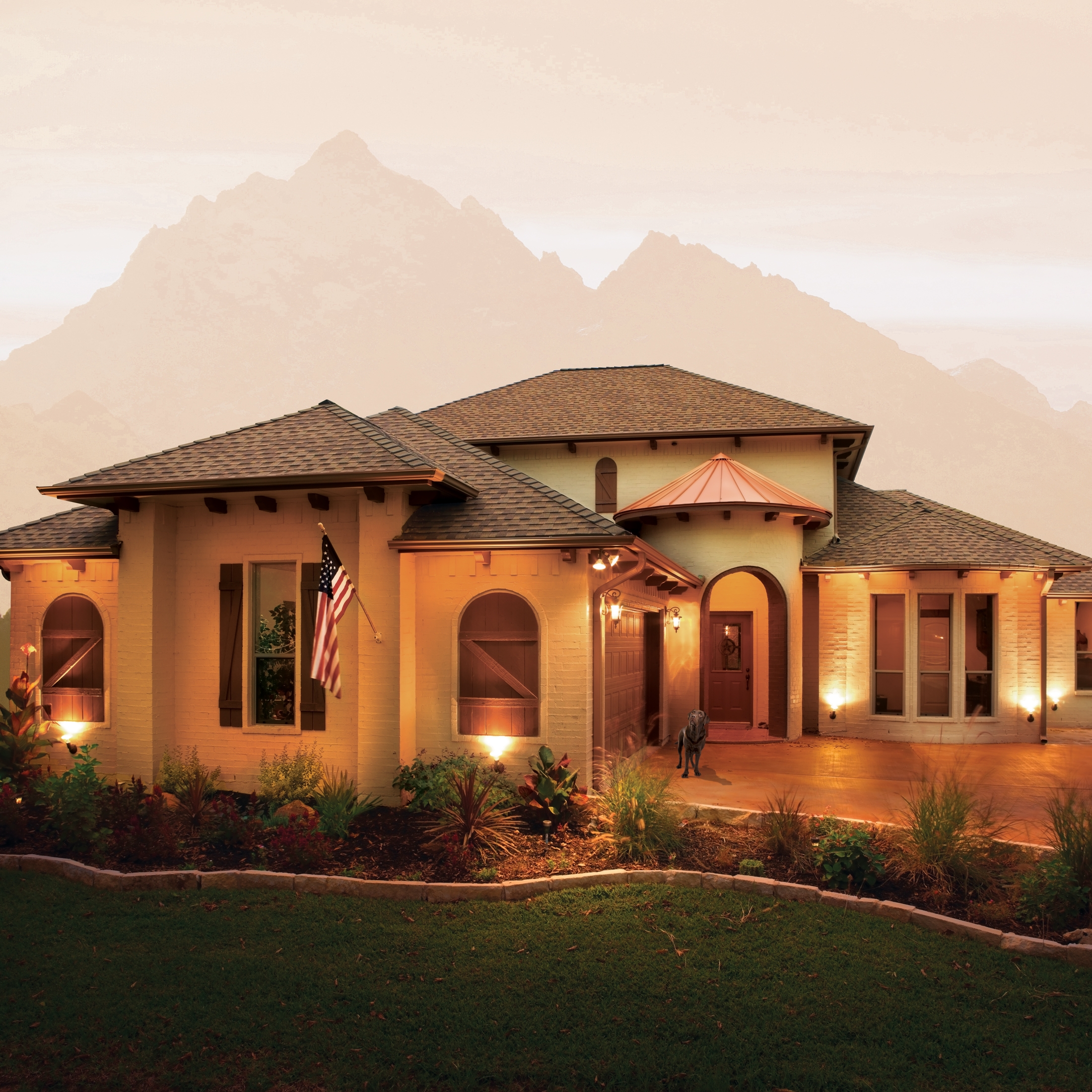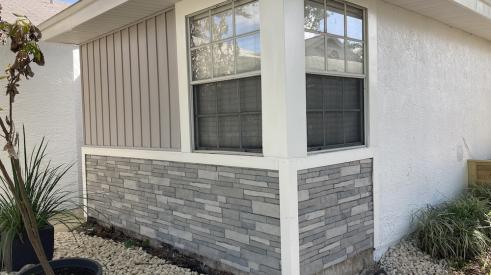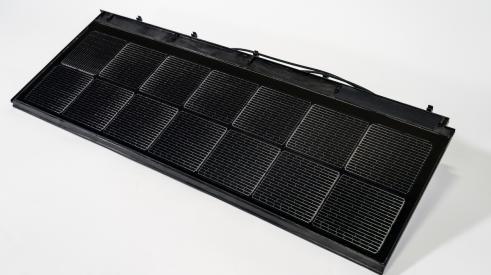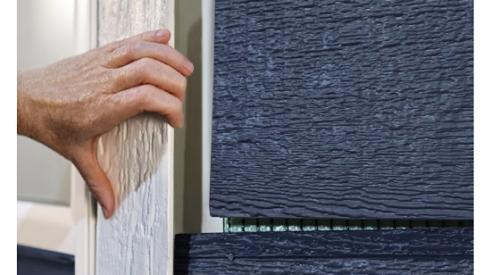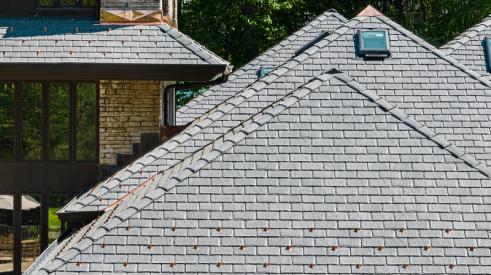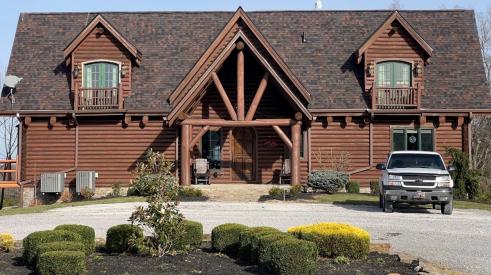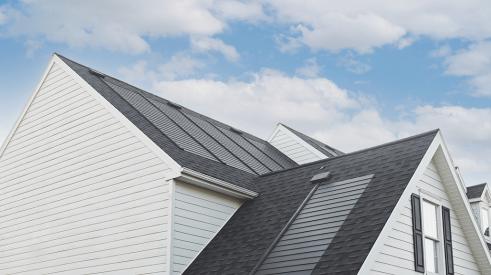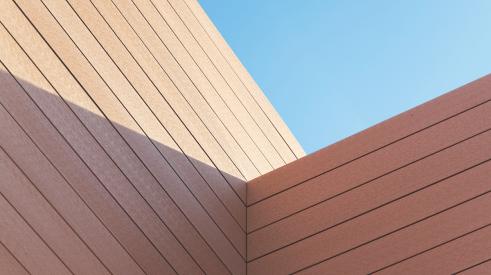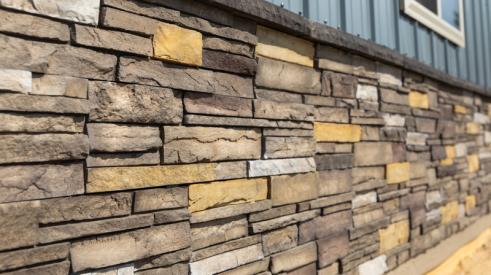A large number of Americans are living in their homes longer. Similar to how aging-in-place design has affected remodeling projects inside the home, homeowners are seeking a high-quality, long-lasting roofing system that can also withstand the forces of Mother Nature.
“The average American used to move every seven years and the statistics we’ve seen recently are closer to between 10 and 15 [years],” says Martha Strick, director of residential product marketing for CertainTeed Roofing. “When homeowners think about replacing their roof maybe once or twice in their lifetime—hopefully, depending on where they live—they’re really looking for something that has long-lasting durability.”
RESOURCES
Boral Roofing
CertainTeed Roofing
DaVinci Roofscapes
GAF
Owens Corning
Paslode
The Tapco Group
The main considerations for greater longevity include: weather resistance—standing up to snow, wind, and hail; integrity of the whole system—having the right fasteners, ventilation, flashing, and underlayment; and low maintenance—maintaining a clean roof surface with ease.
Dealing with snow
With winter in the rearview mirror, many homeowners across the country are either facing damaged roofs that need repair or looking for ways to prevent damage in the future.
“Areas have gotten record snowfalls or the highest in the last 20 years,” says Ray Rosewall, president and CEO of DaVinci Roofscapes. “Suddenly things like snow guards are becoming more important to homeowners.”
As the climate changed over the past two decades, many roofing contractors no longer saw the need for snow guards, but this winter has changed that notion, according to Rosewall.
 “It’s typically reactive when the snow comes off in a big wave and takes out all of the shrubs or the gutters—hopefully it doesn’t hurt anybody,” he says. “Snow guards are definitely something we talk more about when we do training for contractors and distributors.”
“It’s typically reactive when the snow comes off in a big wave and takes out all of the shrubs or the gutters—hopefully it doesn’t hurt anybody,” he says. “Snow guards are definitely something we talk more about when we do training for contractors and distributors.”
Snow guards may eliminate the hazard of falling snow, but they can also exacerbate ice-damming problems by keeping the snow on the roof. The shingles must be able to withstand ice and water buildup, but the rest of the roofing system also plays a critical role.
“It’s not only the shingles but all of the associated accessories that are big parts—the roof deck protection, leak barrier, starter strips, ventilation, ridge caps,” says Leslie Franklin, senior product manager at GAF. “All those pieces are a big part of the puzzle and all have to be independently excellent in their own right.”
Ventilation is imperative to preventing ice dams and even the most basic advancements in a ventilation system can make a huge impact.
“Ventilation is a big layer because it’s hard to understand, but it’s actually quite simple,” says Bert Elliott, product and program manager for Owens Corning. “You need input and you need exhaust. If you have only one or the other, you don’t have a ventilation system.”
Attic insulation can also help maintain a constant temperature on the roof surface, helping to prevent ice damming.
Standing up to hail
In some areas of the U.S. such as Texas, Kansas, Oklahoma, and Colorado, hail can prove detrimental to roofs.
“It makes sense that if a roof is covering your house you want it to be able to withstand weather, and I’m not just talking about rain,” says Jonathan Wierengo, vice president of marketing for The Tapco Group. “I’m talking hail impact.”
Many roofing technologies and materials today have some level of impact resistance, but for repeated weather events, manufacturers have created more durable formulas.
 “Even standard products that aren’t hail-rated are resilient to minor hail storms, but we also offer hail-certified products that we’ve done testing to verify they can stand up to certain hail sizes,” says Wade Shepherd, product strategy and development manager for Boral Roofing. “Class 3 is 1½-inch hail ball tested and Class 4 is 2-inch hail ball tested.”
“Even standard products that aren’t hail-rated are resilient to minor hail storms, but we also offer hail-certified products that we’ve done testing to verify they can stand up to certain hail sizes,” says Wade Shepherd, product strategy and development manager for Boral Roofing. “Class 3 is 1½-inch hail ball tested and Class 4 is 2-inch hail ball tested.”
In the states most prone to treacherous hail, some insurance companies offer discounts on homeowners’ policies for installing Class 4-rated roofing.
“In some of the central states that tend to get severe weather, I’ve heard upwards of 15-to-20 percent off policies are not uncommon,” Wierengo says.
Fighting the wind
In other areas of the country, wind uplift is a major concern. Wind from hurricanes and tornados cause more than $6 billion in damage a year, according to the Environmental Protection Agency.
Choosing the Right Tool for Roofing
Roofing repair work and preventive maintenance services are keeping roofing contractors and remodelers busy, and the combination of the right tools and crew can make all the difference. Choosing between pneumatic versus cordless tools is one issue that should be addressed.
Pneumatic Tools
Pneumatic nailers are roofing workhorses that can get a job done quickly. They have become lightweight, fast-driving, high-powered, and accurate tools that can drive nails of varying lengths.
They allow roofing workers to quickly and precisely adhere base felt and shingles or tiles in record time, and they’re ideal for applications where compressors are already in use and noise on the jobsite is not a hindrance. On large-scale roofing jobs, it makes sense for workers to use pneumatic nailers, hook up air-compressors, and fill pouches with nails to reload while on the roof.
Pneumatic tools also can be used when a roof structure needs to be strengthened, especially when replacing a lightweight roofing material (such as asphalt shingles) with a heavier roofing material (such as concrete tile).
Cordless Options
When danger signs are identified, cordless roofing nailers may be a good option.Specific roof system repair jobs that call for a cordless nailer include: a roof deck with loose boards and popped nails; loose or damaged shingles from inclement weather or shingles showing signs of excessive drying, cracking, and coating deterioration; visible cracks, open joints, or questionable metal counterflashings; flashing applications and vent installations; and ice damming leading to valley leaks.
Despite common misconceptions that the only way to deliver craftsmanship on the job is to manually hammer and nail each shingle in place, roofing contractors are finding cordless tools can offer the same quality but in less time and with less strain on their bodies.
“When you think about some homes that are in the coastal areas or let’s say Florida for instance, we’ve learned a lot in terms of high-wind storms beyond just hurricanes in the last 10-to-20 years,” Strick says. “Folks are looking for shingles that can withstand those types of wind gusts.”
Manufacturer testing has created products meant to keep the roof in place during even the harshest coastal weather, while ASTM standards help contractors and remodelers determine just which type of product works with the average wind speeds in a certain area. From 80-mile-per-hour winds to 150-mile-per-hour winds and above, manufacturers are offering more peace of mind with shingles.
“We go through a lot of testing when we manufacture products...many, many tests. We torture our materials just so we know that when it gets out in the field it will perform as intended,” Franklin says. “All our shingles pass the most stringent wind test.”
Paired with these high-performance shingles, the rest of the roofing system must also be able to stand up to high wind conditions. Wierengo has found a growing awareness in coastal areas for the fasteners that are used when installing a roof.
“If you can think of a standard galvanized roofing nail which you can use on the majority of products offered in the market, that galvanized roofing nail has a certain shelf life,” he says. “In coastal areas, you have people and contractors who are more aware of the fastener types and corrosion, so they might go away from galvanized and use a stainless steel fastener, or a better roofing fastener.”
As roofing warranties get longer, it is important to weigh the performance of the fastener compared to that of the shingles or tiles in all areas, not just coastal locations.
“We recommend when you install our product that you use ideally a stainless steel fastener because you don’t want the fastener to fail over the 50-year life,” Rosewall says. “Some fasteners just aren’t designed to last that long; they’re designed for a 15-to-25-year life.”
Manufacturers, roofing contractors, and remodelers are paying attention to nailing zones and nailing areas on shingles to increase performance as well, according to Elliott.
“We have our reinforcing SureNail fabric that allows a guy with a nail gun to hit the target and gives the contractor peace of mind.” he says. “SureNail fabric provides reinforcement from a wind-protection point of view.”
For Boral Roofing’s tile roofs, nails, screws, and clips can all be used to ensure the tiles stay on under certain wind conditions, but there is one more option as well.
“There’s foam-fastening tiles to the roof, which has become very popular in recent years in Florida where the foam is a polyurethane-expanded foam that bonds the tile to the roof deck,” Shepherd says. “It’s a very strong method for fastening tiles for very-high-wind areas.”
Minimizing routine maintenance
Manufacturers are making sure the day-to-day and year-to-year maintenance on roofs (when not faced with inclement weather) is as simple as possible.
Wierengo has found that just as people want low maintenance in the rest of the house, they require this for the roof as well. His one tip is periodically making sure—or having a professional make sure—there are not any branches or debris that could clog up the gutters on the roof.
 “A good, clean roof surface is something you always want to maintain,” Wierengo says. “The only way to have damage is to have products decaying on top of the roof.”
“A good, clean roof surface is something you always want to maintain,” Wierengo says. “The only way to have damage is to have products decaying on top of the roof.”
The same periodic maintenance is also recommended on tile roofs.
“There isn’t really any significant maintenance that really needs to be done other than checking for broken tiles every once in a while,” Shepherd says. “Tiles don’t degrade over time so as long as they’re in good condition, they’ll last for a very long time.”
Algae and mold concerns are also less of a worry for many roofing materials now than in the past.
Fairly easy maintenance coupled with a roof that holds up well in different weather conditions makes for a more aesthetically pleasing roof as well. For many homeowners, getting a strong return on investment is the main priority.
“As the economy is improving, people are either readying their homes by getting them nicer to stay longer term or trying to sell,” Franklin says. “If the roof is in poor condition, it reflects poorly or less favorably upon the house.” PR
Manufacturers have found ways for roofing systems as a whole to withstand harsh conditions more now than ever before.
Add new comment
Related Stories
Pro's Picks: A Quick Install Composite Stone
This pro completed a high volume facelift project months ahead of schedule
Innovative Products: Durable, Low-Profile Solar Shingles
Conventional solar panels are already outdated
· sponsored
Siding trim innovations to save time and hassle
Diamond Kote introduces innovative trim designed around installer wants
· sponsored
Contractors Embrace Province™ Slate
4 Colorful Takeaways from Roofing Contractors
Why residential roofing contractors are more mindful of color when it comes to shingle selection
5 Roofing Trends Discovered at IRE 2023
Observations made from the show floor of the largest roofing event in North America
Innovative Products: GAF Energy Timberline Solar Shingles
GAF Energy’s latest innovation has taken the solar world by storm
Innovative Products: Modern Mill ACRE Siding
A wood alternative that’s easy to use, durable, and green
· sponsored
Why Homeowners and Pros Prefer Stone Veneer to Stone
With the depth of selection in Westlake Royal Building Products, builders and homeowners have an almost-endless range of design possibilities to explore. Ben Drury, Product Development Manager for their exterior product brands, explains why Versetta Stone is so effective in so many different applications.



